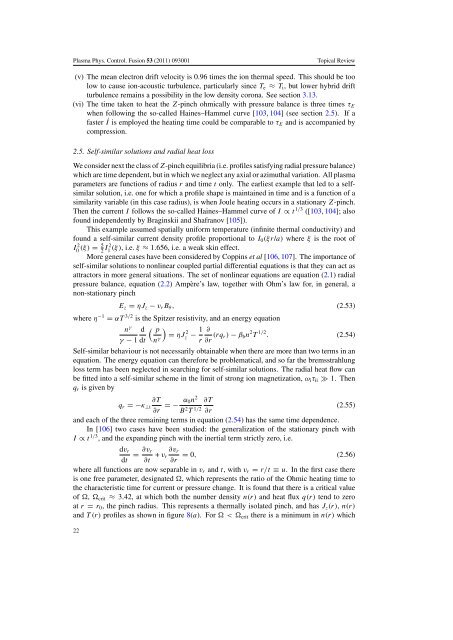You also want an ePaper? Increase the reach of your titles
YUMPU automatically turns print PDFs into web optimized ePapers that Google loves.
Plasma Phys. Control. Fusion 53 (2011) 093001<br />
Topical Review<br />
(v) The mean electron drift velocity is 0.96 times <strong>the</strong> ion <strong>the</strong>rmal speed. This should be too<br />
low to cause ion-acoustic turbulence, particularly since T e ≈ T i , but lower hybrid drift<br />
turbulence remains a possibility in <strong>the</strong> low density corona. See section 3.13.<br />
(vi) The time taken to heat <strong>the</strong> Z-<strong>pinch</strong> ohmically with pressure balance is three times τ E<br />
when following <strong>the</strong> so-called Haines–Hammel curve [103, 104] (see section 2.5). If a<br />
faster I˙<br />
is employed <strong>the</strong> heating time could be comparable to τ E and is accompanied by<br />
compression.<br />
2.5. Self-similar solutions and radial heat loss<br />
We consider next <strong>the</strong> class <strong>of</strong> Z-<strong>pinch</strong> equilibria (i.e. pr<strong>of</strong>iles satisfying radial pressure balance)<br />
which are time dependent, but in which we neglect any axial or azimuthal variation. All plasma<br />
parameters are functions <strong>of</strong> radius r and time t only. The earliest example that led to a selfsimilar<br />
solution, i.e. one for which a pr<strong>of</strong>ile shape is maintained in time and is a function <strong>of</strong> a<br />
similarity variable (in this case radius), is when Joule heating occurs in a stationary Z-<strong>pinch</strong>.<br />
Then <strong>the</strong> current I follows <strong>the</strong> so-called Haines–Hammel curve <strong>of</strong> I ∝ t 1/3 ([103, 104]; also<br />
found independently by Braginskii and Shafranov [105]).<br />
This example assumed spatially uniform temperature (infinite <strong>the</strong>rmal conductivity) and<br />
found a self-similar current density pr<strong>of</strong>ile proportional to I 0 (ξr/a) where ξ is <strong>the</strong> root <strong>of</strong><br />
I0 2(ξ) = 5 2 I 1 2 (ξ), i.e. ξ ≈ 1.656, i.e. a weak skin effect.<br />
More general cases have been considered by Coppins et al [106, 107]. The importance <strong>of</strong><br />
self-similar solutions to nonlinear coupled partial differential equations is that <strong>the</strong>y can act as<br />
attractors in more general situations. The set <strong>of</strong> nonlinear equations are equation (2.1) radial<br />
pressure balance, equation (2.2) Ampère’s law, toge<strong>the</strong>r with Ohm’s law for, in general, a<br />
non-stationary <strong>pinch</strong><br />
E z = ηJ z − v r B θ , (2.53)<br />
where η −1 = αT 3/2 is <strong>the</strong> Spitzer resistivity, and an energy equation<br />
n γ d<br />
( p<br />
)<br />
= ηJ 2<br />
γ − 1 dt n γ z − 1 r<br />
∂<br />
∂r (rq r) − β b n 2 T 1/2 . (2.54)<br />
Self-similar behaviour is not necessarily obtainable when <strong>the</strong>re are more than two terms in an<br />
equation. The energy equation can <strong>the</strong>refore be problematical, and so far <strong>the</strong> bremsstrahlung<br />
loss term has been neglected in searching for self-similar solutions. The radial heat flow can<br />
be fitted into a self-similar scheme in <strong>the</strong> limit <strong>of</strong> strong ion magnetization, ω i τ ii ≫ 1. Then<br />
q r is given by<br />
∂T<br />
q r =−κ ⊥i<br />
∂r =− α 0n 2 ∂T<br />
(2.55)<br />
B 2 T 1/2 ∂r<br />
and each <strong>of</strong> <strong>the</strong> three remaining terms in equation (2.54) has <strong>the</strong> same time dependence.<br />
In [106] two cases have been studied: <strong>the</strong> generalization <strong>of</strong> <strong>the</strong> stationary <strong>pinch</strong> with<br />
I ∝ t 1/3 , and <strong>the</strong> expanding <strong>pinch</strong> with <strong>the</strong> inertial term strictly zero, i.e.<br />
dv r<br />
= ∂v r ∂v r<br />
+ v r = 0, (2.56)<br />
dt ∂t ∂r<br />
where all functions are now separable in v r and t, with v r = r/t ≡ u. In <strong>the</strong> first case <strong>the</strong>re<br />
is one free parameter, designated , which represents <strong>the</strong> ratio <strong>of</strong> <strong>the</strong> Ohmic heating time to<br />
<strong>the</strong> characteristic time for current or pressure change. It is found that <strong>the</strong>re is a critical value<br />
<strong>of</strong> , crit ≈ 3.42, at which both <strong>the</strong> number density n(r) and heat flux q(r) tend to zero<br />
at r = r 0 , <strong>the</strong> <strong>pinch</strong> radius. This represents a <strong>the</strong>rmally isolated <strong>pinch</strong>, and has J z (r), n(r)<br />
and T(r)pr<strong>of</strong>iles as shown in figure 8(a). For < crit <strong>the</strong>re is a minimum in n(r) which<br />
22














